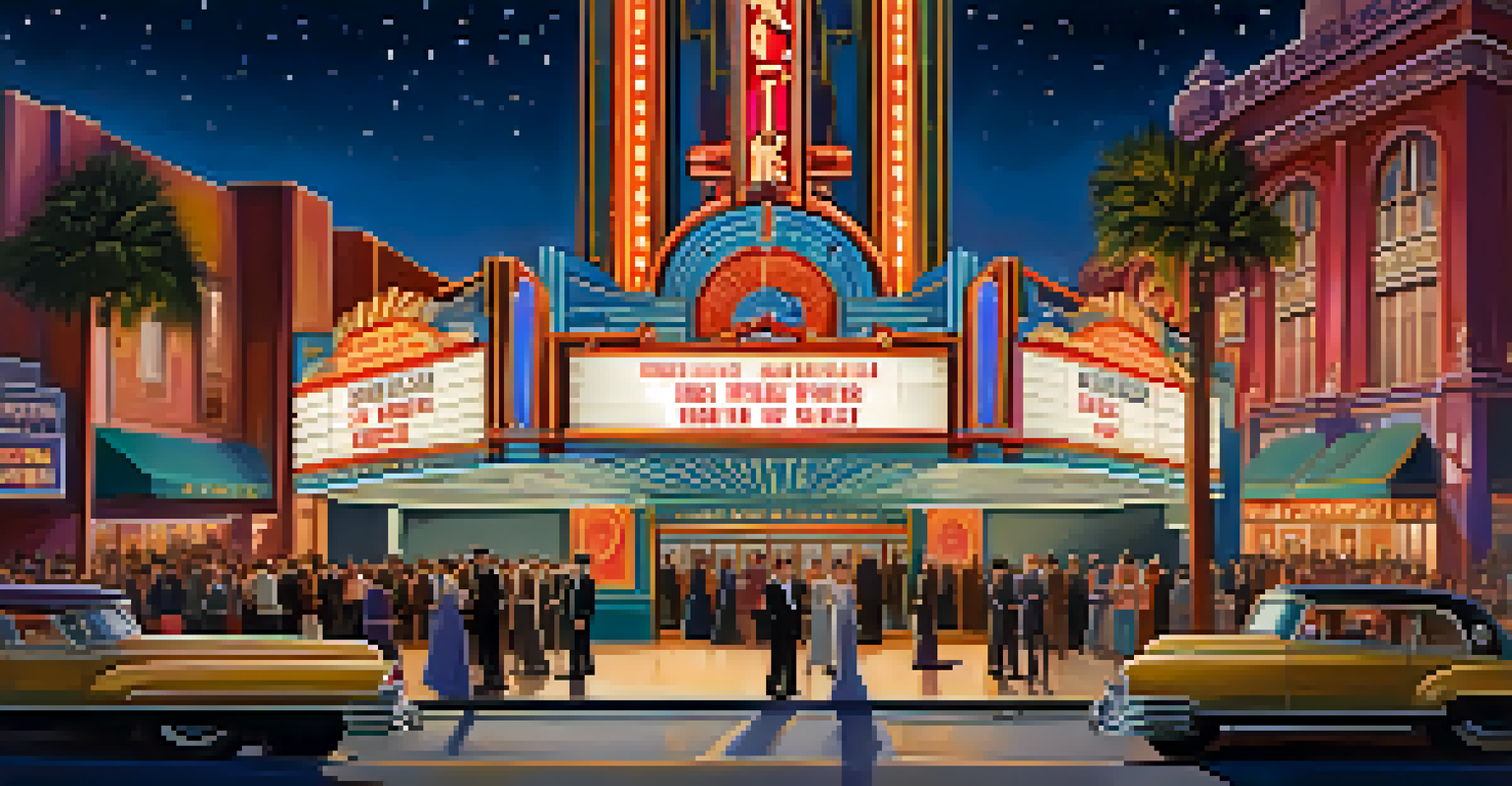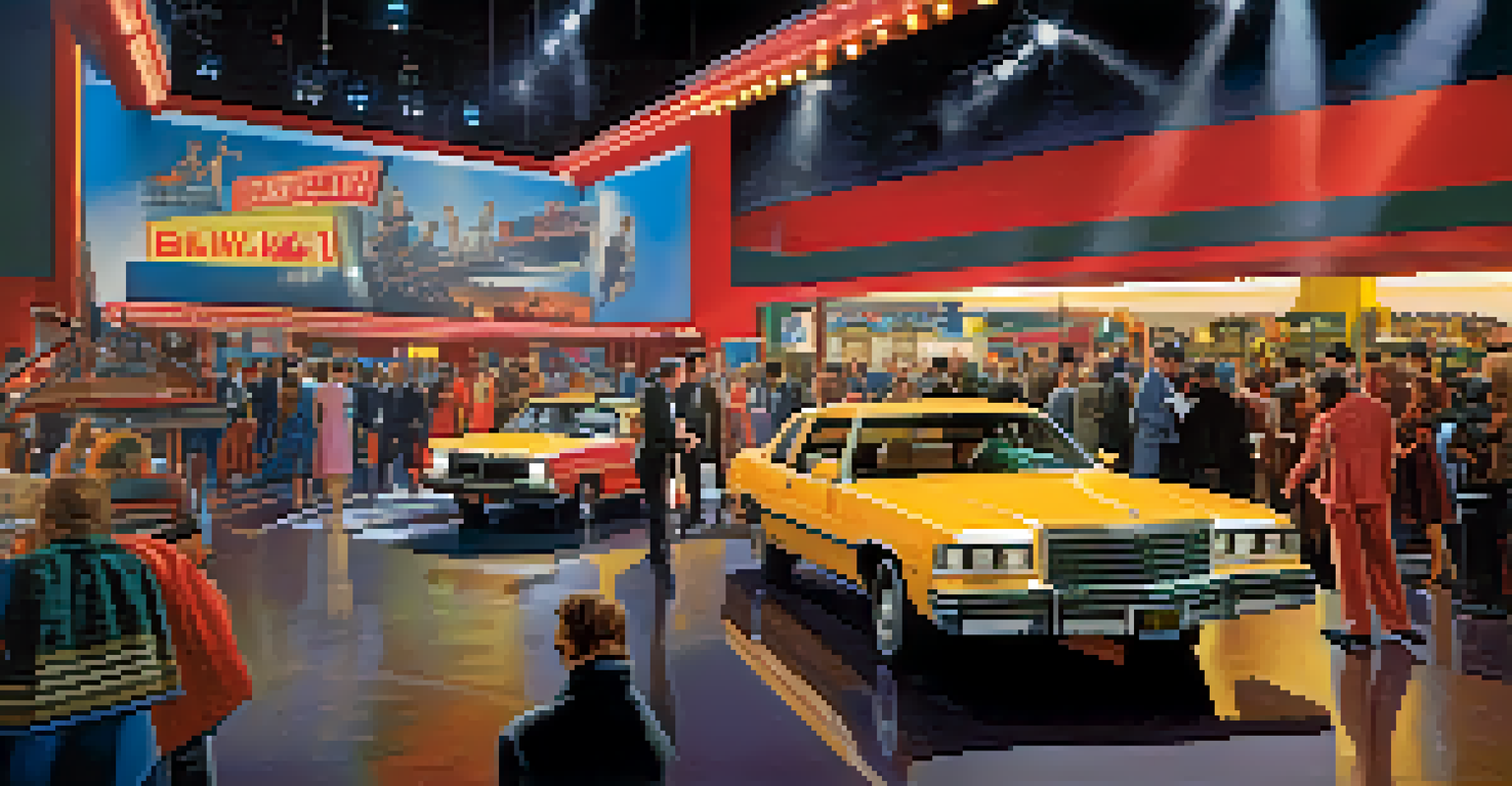The Birth and Growth of Hollywood: A Neighborhood History

The Early Days: A Small Farming Community
Before the glitz and glamour, Hollywood was primarily a modest farming community. Established in the late 1800s, it featured orchards and small plots of land, where residents cultivated crops and enjoyed a quiet lifestyle. The area was largely rural, with a few homes scattered across the landscape.
Hollywood is a place where they shoot too many pictures and not enough actors.
As the years went by, Hollywood began attracting attention due to its mild climate and scenic views. In 1887, H. J. Whitley, known as the 'Father of Hollywood,' purchased land and envisioned a thriving community. His vision started to take shape with the construction of homes and businesses, setting the stage for future growth.
This early foundation paved the way for Hollywood's transformation, as more settlers arrived, drawn by the promise of a burgeoning community. The unique charm of the area began to attract artists and visionaries who would soon change its destiny forever.
The Birth of the Film Industry in Hollywood
The film industry began to take root in Hollywood around the early 1900s. Pioneering filmmakers recognized the area's potential for year-round shooting, thanks to its diverse landscapes and favorable weather. By 1910, studios like the Nestor Company set up shop, marking the beginning of Hollywood as we know it today.

As filmmakers flocked to the area, Hollywood became a hub for creativity and innovation. The first feature-length film shot in Hollywood, 'The Squaw Man,' was released in 1914, capturing the attention of audiences. This success ignited a film frenzy, with more studios emerging and stories being told on the big screen.
Hollywood's Humble Beginnings
What started as a small farming community transformed into a vibrant arts hub, paving the way for its future as a global entertainment capital.
The combination of talent and ambition fueled Hollywood's growth, leading to the establishment of major studios like Paramount, Universal, and Warner Bros. This period not only transformed the neighborhood but also laid the groundwork for the global film industry.
The Golden Age of Hollywood: 1920s to 1950s
The 1920s to the 1950s is often referred to as the Golden Age of Hollywood, characterized by the rise of the star system and the introduction of sound in films. Iconic actors and actresses like Marilyn Monroe and Humphrey Bogart became household names, captivating audiences worldwide. The allure of Hollywood drew aspiring stars from all over, eager to make their mark.
The movies are the only business where you can go out front and applaud yourself.
During this time, lavish movie theaters were built, creating a glamorous backdrop for film premieres. The famous Hollywood Walk of Fame was established, celebrating the achievements of those in the industry. The cultural impact of Hollywood grew immensely, with films influencing fashion, music, and even social attitudes.
However, this era wasn't without its challenges. The Great Depression and World War II tested the industry, but Hollywood adapted by producing uplifting films that provided escapism. This resilience helped solidify its reputation as the entertainment capital of the world.
Post-War Changes: The Rise of Television
As the world emerged from WWII, Hollywood faced new competition: television. The 1950s saw the rise of TV as a primary source of entertainment, leading some to fear for the future of cinema. However, Hollywood adapted by reinventing itself and producing films that offered experiences television couldn't match.
The introduction of Cinemascope and other technological advancements allowed filmmakers to create visually stunning epics, drawing audiences back to theaters. Movies like 'Ben-Hur' and 'The Ten Commandments' showcased the grandeur of cinema, solidifying its place in popular culture.
The Evolution of Film and TV
From the birth of the film industry to the rise of television, Hollywood has continually adapted to changing entertainment landscapes.
While television became a staple in American homes, Hollywood found ways to coexist, eventually leading to collaborations between both mediums. This adaptability marked a significant shift in the entertainment landscape, ensuring Hollywood's relevance in a rapidly changing world.
Hollywood's Evolution in the 1960s and 1970s
The 1960s and 1970s brought a wave of social change that influenced Hollywood significantly. Filmmakers began to tackle more complex and controversial themes, reflecting the societal upheaval of the time. Movies like 'Easy Rider' and 'The Graduate' challenged traditional narratives, resonating with a generation seeking authenticity.
This era also saw the emergence of new directors, such as Martin Scorsese and Francis Ford Coppola, who pushed creative boundaries and redefined storytelling. Their unique visions contributed to a renaissance in filmmaking, captivating audiences with innovative techniques and compelling narratives.
The impact of this period extended beyond cinema; it reshaped how Hollywood approached storytelling and character development. As filmmakers embraced diversity and complexity, Hollywood became a mirror reflecting the changing values of society.
The Blockbuster Era: 1980s to 2000s
The late 20th century marked the rise of the blockbuster, with films like 'Star Wars' and 'Jaws' changing the game entirely. These high-budget productions became cultural phenomena, drawing massive audiences and generating unprecedented revenue. Hollywood quickly adapted to this new model, prioritizing spectacle and star power in filmmaking.
Studios began investing heavily in marketing and merchandising, creating franchises that extended beyond the silver screen. This shift allowed Hollywood to dominate the global box office, establishing a new standard for success in the industry. The emphasis on blockbuster films led to a focus on visual effects and larger-than-life storytelling.
Resilience in the 21st Century
Despite facing challenges from streaming platforms, Hollywood's innovation and adaptability ensure its ongoing relevance in the entertainment world.
However, this era also sparked discussions about creativity versus commercialism, as independent films struggled to find their footing amidst the blockbuster frenzy. While Hollywood thrived economically, many filmmakers sought to balance artistic vision with audience appeal.
Hollywood in the 21st Century: Challenges and Innovations
As we moved into the 21st century, Hollywood faced a host of challenges, including the rise of digital streaming platforms like Netflix and Hulu. With audiences increasingly turning to on-demand content, traditional cinema experienced a decline, prompting Hollywood to rethink its strategies. The industry began exploring collaborations with streaming services to reach wider audiences.
Innovations in technology also changed the landscape of filmmaking, with advancements in CGI and virtual reality offering new storytelling possibilities. Filmmakers are now able to create immersive experiences that captivate viewers in ways previously unimaginable, pushing the boundaries of creativity.

Despite these challenges, Hollywood remains a resilient force in the entertainment world. Its ability to adapt and embrace change continues to redefine the industry, ensuring that Hollywood's legacy of creativity and storytelling endures for generations to come.